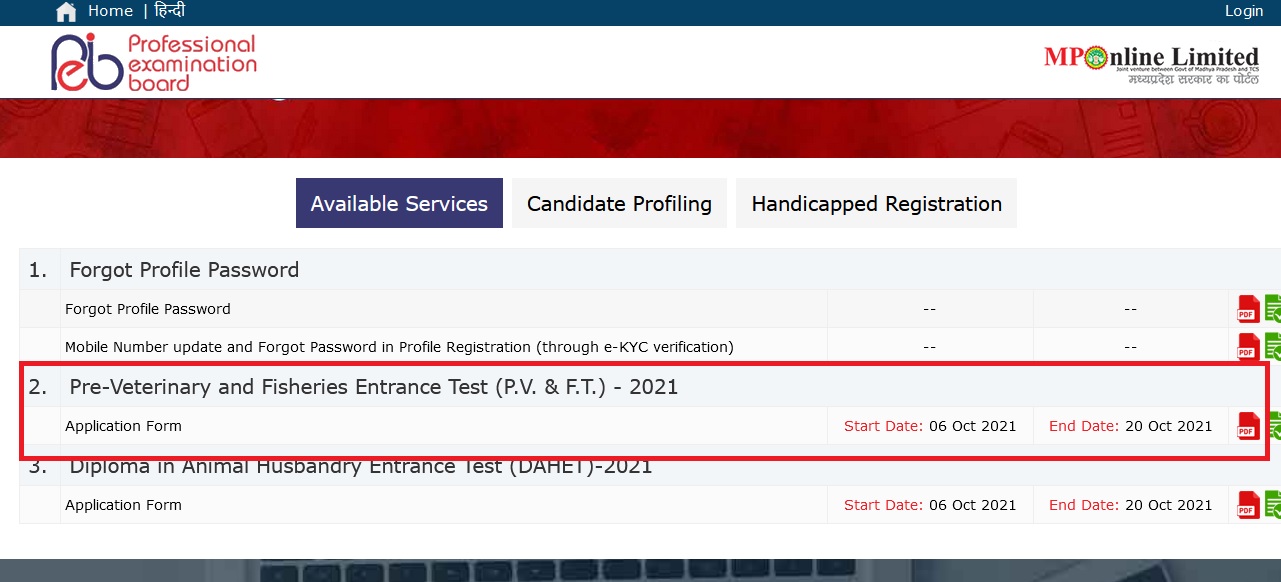peb.mp.gov.in Pre-Veterinary & Fishery Entrance Test (PV&FT) 2021 : Madhya Pradesh
Organisation : Madhya Pradesh Professional Examination Board
Exam Name : Pre-Veterinary & Fishery Entrance Test (PV&FT) 2021
Applicable For : Students passed 12th with Physics, Chemistry, Biology, and English subjects
Applicable State/UT : Madhya Pradesh
Last Date : 20th Oct 2021
Website : https://esb.mp.gov.in/advertisement/Important_message_candidate.htm
| Want to comment on this post? Go to bottom of this page. |
|---|
Contents
PEB MP PV&FT Exam
Madhya Pradesh Professional Examination Board, Pre-Veterinary & Fishery Entrance Test (PV&FT) 2021
Related / Similar Exam : Madhya Pradesh PEB PAT 2021 Exam

Eligibility Criteria
Educational Qualification
Candidates of Madhya Pradesh state who have completed 12th level examination with Physics, Chemistry, Biology, and English subjects from a recognized board.
Age Limit
Candidates must have a minimum age of 17 years to apply for the PVFT notification.
Note:
The applicant must be a Domicile of M.P. State
Exam Pattern
Mode of Examination: The MP PVFT 2021 is conducted in online mode.
Negative Marking: There is no negative marking.
Duration of Examination: The duration of the examination is 2 hours.
Language of Exam: The MP PVFT 2021 is conducted in both English and Hindi.
Number of Shifts: The exam is conducted in multiple shifts.
Marks allotted for correct answer: 1 mark is allotted.
Number of alternatives: There are 4 alternatives in total.
How To Apply?
Online Form – Pre-Veterinary & Fishery Entrance Test (PV&FT) – 2021 (Start from 06/10/2021)
Apply Online : https://esb.mp.gov.in/
Application Fee
For General candidates: Rs. 400/-
For ST/SC/OBC candidates: Rs. 200/-
Download Notification Here : https://www.entrance.net.in/uploads/pdf2021/19903-Rule.pdf
Syllabus
Botany
Diversity in Living Organisms: Tools for study of Taxonomy – Museum, Zoos, Herbaria, Botanical Garden.
Biological classification: Five Kingdom classification, Binomial nomenclature, External morophology and life cycle of Spriogyra, Mucor, Funaria, Selaginella and Pinus. Salient features and classification of\ Monera, Protista, Fungi, plants and animals into major groups. Lichens, Viruses and viroids. Classification of plants into major groups- Algae, Bryophyta, Pteridophyta, Gymnospermae and Angiospermae.
Difference between Prokaryote and Eukaryotes; Structure, reproduction and economic importance of Mycoplasma, Bacteriophage, Bacteria and Cynobacteria.
Structural organization of cell: Cell theory, Light and Electron Microscopic view of cell (plant and animal), Structure and functions of cell organelles- Nucleus, Mitochondria, Chloroplast, Endoplasmic reticulum, Golgi complex, Iysosome, microbodies, microfilaments, Ribosome, Centrioles and Vacuoles, Plastid, Eukaroytic Chromosome (Morphology), cell and plasma membrane; difference between plant and animal cell, cell division, cell cycle, significance of mitosis and meiosis.
Biomolecules: Structure, function, chemical nature, mode of action and importance of carbohydrates, proteins, lipids, nucleic acids, enzymes and growth hormones with reference to their classification.
Reproduction in Plants: Asexual and Sexual- Binary fission, Sporulation, budding, gemmules, fragmentation and Vegetative propagation of plant, elementary sequence of developmental process, Pollination, Apomixes, Parthenocarpy, Elementary knowledge of microsporogenesis, megasporogenesis, fertilization, endosperm and embryo development in Angiosperms. Pollination types, Out breeding devices, Pollen Pistil Interaction, Double Fertilization, Post Fertilization events, development of seed and formation of fruit. Tissues, Anatomy and functions of different plant parts – root, stem, leaf, inflorescence (cymose and racemose), flower, fruit and seed. Plant Physiology:
Transport in plants: Movement of water, gases and nutrients, Cell to cell transport, diffusion, facilitated diffusion, active transport; plant-water relations, imbibition, water potential, osmosis, plasmolysis; long distance transport of water- absorption, apoplast, symplast, transpiration pull, root pressure and guttation; transpiration, opening and closing of stomata; uptake and translocation of mineral nutrients – transport of food, phloem transport, mass flow hypothesis; diffusion of gases
